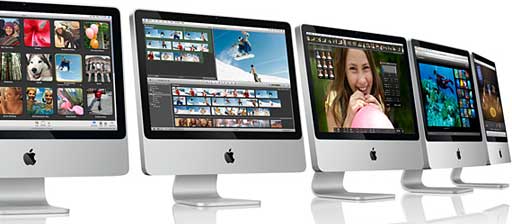Apple added an 8-core build-to-order option for the Mac Pro on April 4. The new top-end
model had two 3.0 GHz quad-core Xeon CPUs.
On May 15, Apple improved MacBook speed to 2.16
GHz at the top, doubled RAM on the base model to 1 GB, and moved to
larger hard drives.
The MacBook Pro models were updated on June 5, adopting the Santa
Rosa chipset, an 800 MHz system bus, and Nvidia GeForce 8600M GT
graphics. The 15"
MacBook Pro ran at 2.2 GHz or 2.4 GHz, and a 2.6 GHz build-to-order
option was available for those who needed the extra power. The 17" MacBook Pro
normally ran at 2.4 GHz, and a 2.6 GHz option was also available for
it. Once 4 GB modules became available in 2008, users discovered that
the Santa Rosa notebooks could work with up to 6 GB of RAM.
The biggest problem with the 2007 MacBook Pro models had to do with
the GeForce 8600 graphics processors, many of which were defective.
According to some sources, every
production run for the GPU had defective chips.
iPhone
The biggest tech event of the year was the introduction of the
original iPhone on June 30. People lined up for hours to buy Apple's
first mobile phone, a smart phone that combined a cell phone, an iPod,
and an OS X computer. (Note that Apple calls it OS X, not Mac OS X.)
The Mac mini was updated
on August 7, the last Mac to move from Intel Core Duo processors to the
improved Core 2 Duo, which includes 64-bit support. Clock speeds were
1.83 GHz for the entry-level Combo drive model and 2.0 GHz for the
SuperDrive version. As of February 2008, this is still the current
model.

At the same time, Apple introduced a redesigned iMac. The new
models came in 20" and 24" sizes (no more 17" iMac), were built using
aluminum and glass, and had a glossy display. At the top of the line
was a 2.8 GHz build-to-order 24" iMac.
Apple introduced the iPod touch on Sept. 5, in most respects an
iPhone - but without mobile phone or camera capabilities. The iPod
touch runs the same iPhone version of OS X as the iPhone.
At the same time, Apple rolled out a redesigned iPod nano, shorter
and wider than earlier models. The traditional hard drive iPod was
updated and renamed at the same time: The iPod classic had an aluminum
face and came in 80 GB and 160 GB capacities. The tiny iPod shuffle was
updated with a new range of colors.
The MacBook
received another update on October 31, when it adopted Intel's Santa
Rosa chipset and an 800 MHz system bus. The new models ran at 2.0 and
2.2 GHz, scarcely faster than the models they replaced. This also
marked the MacBook's move to Intel X3100 graphics - more powerful than
the earlier GMA 950, but also more memory hungry. The new GPU used 144
MB of system memory.
Leopard
For Mac users, the biggest event of the year was the release of Mac
OS X 10.5 "Leopard" on October 26. Where Mac OS X 10.4 "Tiger" had been
available in different versions for PowerPC and Intel Macs, Leopard was
a universal release that supported both hardware platforms.
New technologies included Time Machine (automated backup), a new
Finder, and a 3D Dock.
For the first time, there was no Classic Mode in OS X - not even
with PowerPC Macs. Where Mac users dependent on Classic apps had
avoided Intel Macs, which never had Classic support, they now avoided
Leopard as well. (For those who need access to Classic apps and the
Classic Mac OS, Sheepshaver
emulates a PowerPC Mac and supports Mac OS 7.5.2 through 9.0.4. It
works, although it gives you an emulated Mac in a fixed window, not the
same experience users are accustomed to with Classic Mode.)
Unsupported OS X 10.5
Hardware requirements for Leopard include 512 MB of RAM and an 867
MHz G4 or better. Users have discovered several ways to install OS X
10.5 on unsupported hardware, including G3 Macs with G4 upgrades and
AGP graphics. In some instances, they have even scrounged up the kext
files from a developer release and hacked Leopard to work with Macs
with PCI graphics, such as the Beige Power Mac G3 from
1997.
Low End Mac provided reader
reports on successes, failures, and glitches within days of
Leopard's release, and in December Dylan McDermond shared his Open Firmware hack that
allowed users to run an unmodified Leopard installer on a Mac slower
than 867 MHz. This information was used by the folks at iCode to create
LeopardAssist, a
free program that automates the process and eliminates the need to
fiddle with OpenFirware on your own.
Next - 2008: Mac Pro with 4-core Xeon, MacBook
Air, Unibody MacBook and MacBook Pro



